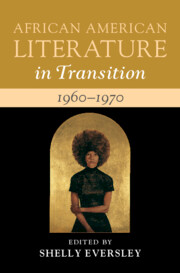Book contents
- African American Literature in Transition, 1960–1970
- African American Literature In Transition
- African American Literature in Transition, 1960–1970
- Copyright page
- Contents
- Contributors
- Preface
- Acknowledgments
- Chronology
- Introduction
- I Poetry and Music
- Chapter 1 The Society of Umbra and the Coming of the Black Aesthetic
- Chapter 2 Robert Hayden, the Black Arts Movement, and the Politics of Aesthetic Distance
- Chapter 3 Breathing
- Chapter 4 Reconsidering “the Revolution in Music”
- II Culture and Politics
- III Beyond the Canon
- Index
- References
Chapter 1 - The Society of Umbra and the Coming of the Black Aesthetic
from I - Poetry and Music
Published online by Cambridge University Press: 10 November 2022
- African American Literature in Transition, 1960–1970
- African American Literature In Transition
- African American Literature in Transition, 1960–1970
- Copyright page
- Contents
- Contributors
- Preface
- Acknowledgments
- Chronology
- Introduction
- I Poetry and Music
- Chapter 1 The Society of Umbra and the Coming of the Black Aesthetic
- Chapter 2 Robert Hayden, the Black Arts Movement, and the Politics of Aesthetic Distance
- Chapter 3 Breathing
- Chapter 4 Reconsidering “the Revolution in Music”
- II Culture and Politics
- III Beyond the Canon
- Index
- References
Summary
This chapter traces the ways in which, in the early 1960s, the Society of Umbra, an informal community of African American writers, artists, musicians, and activists, combined elements of bohemianism and Black cultural self-determination to lay the groundwork for the Black Arts Movement. It chronicles the emergence of the group from various activist and artist organizations of the Lower East Side of New York City as these African Americans became discontent with the political limitations of bohemian nonconformity and the artistry committed only to anti-bourgeois self-cultivation. Analyzing the poetry of Lorenzo Thomas, David Henderson, and Calvin Hernton, it clarifies how these poets pursued a shared attempt to reveal how bohemian libidinal energies could be transformed from personal artistry and individual redemption into a revolutionary Black nationalist consciousness that could, in turn, lead to collective action.
- Type
- Chapter
- Information
- African American Literature in Transition, 1960–1970Black Art, Politics, and Aesthetics, pp. 23 - 49Publisher: Cambridge University PressPrint publication year: 2022



